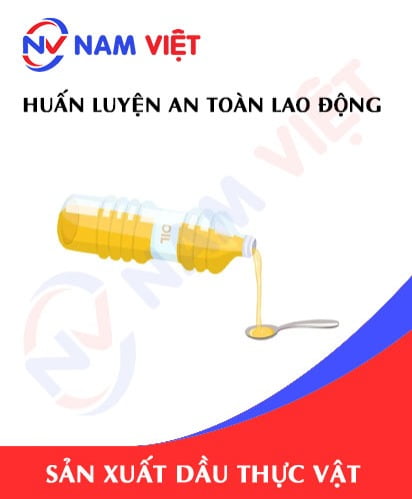Occupational Safety Training in Solid Alcohol Manufacturing
99,000 ₫
Note: The above price is calculated for one person, the price may fluctuate depending on the number of trainees participating in the course and the dynamics of the market. For more accurate price support, please refer to the quotation table or contact our consulting staff directly.
Occupational safety is an important issue in solid alcohol manufacturing factories and needs to be addressed promptly to ensure the health and safety of workers, as well as to enhance the reputation of businesses. The Occupational safety training course is one of the effective solutions to raise awareness of accident prevention for workers participating in solid alcohol production.
Table of Contents
Toggle1. Overview of Solid Alcohol
a. What is Solid Alcohol?
- Solid alcohol and dry alcohol are two terms commonly used to refer to the same product, which is polyvinyl alcohol.
- Polyvinyl alcohol (also called solid alcohol or dry alcohol) is a type of dry substance with highly flammable properties and is widely used in various fields. Solid alcohol is produced by creating a vinyl polymer solution, then removing all water and impurities, if any, by boiling or using chemical absorbents. After that, this polymer is cut into small granules or sheets and used as a fuel to generate fire or provide heat in industrial applications.
- In summary, solid alcohol and dry alcohol are both terms referring to the same product, polyvinyl alcohol.
- According to the report of the Department of Occupational Safety and Hygiene (Ministry of Labor, War Invalids and Social Affairs), Vietnam’s dry alcohol production reaches about 8,000 tons per year, an increase of 30-40% compared to the previous year. Export production accounts for a large proportion, especially to Asian markets.
- However, the solid alcohol and dry alcohol production industry also faces many challenges, notably labor safety and environmental protection. The production of solid alcohol requires strict compliance with regulations on occupational safety, quality, and environmental protection to ensure workers’ health and meet international market requirements.

b. Machinery for Solid Alcohol Production
The machinery for solid alcohol production includes:
- Dissolving machine: used to dissolve vinyl polymer in a solution.
- Polishing machine: used to polish and smooth the surface of solid alcohol products.
- Press machine: used to press solid alcohol products into sheets or small granules.
- Cutting machine: used to cut solid alcohol products into different sizes and shapes.
- Packing machine: used to package solid alcohol products into containers for storage and transport.
In addition, there are other auxiliary equipment such as: mixing tanks, dryers, absorbers, water separators, refrigeration units, etc.
Depending on the production scale and purpose, the above machinery and equipment can be used separately or combined into an automatic and efficient production line.

c. Typical Solid Alcohol Manufacturers
Currently, there are many solid alcohol manufacturers in Vietnam. Some typical companies include:
- Tan An Joint Stock Company – Dong Nai: a leading enterprise in solid alcohol production in Vietnam, with a large production scale and considered to have the best product quality in the industry.
- Vietnam Pharmaceutical and Medical Equipment Joint Stock Company (Vimedimex): supplies solid alcohol products for the medical field, especially in operating rooms and clinics.
- Vietnam Science and Technology Production and Trading Joint Stock Company (Vinastar): one of the pioneering enterprises in dry alcohol production in Vietnam, particularly dry alcohol used in welding.
- Southern Dry Alcohol Joint Stock Company (MSD): a major dry alcohol producer in southern Vietnam. Its products are widely applied in various fields, from welding and packaging to medical and explosive applications.
- Hai Phong Dry Alcohol Company Limited (HP Alcohol): one of the leading dry alcohol producers in northern Vietnam, with large-scale production and products meeting international standards.
The above are some typical solid alcohol manufacturers in Vietnam, although many other enterprises also operate in this field.
d. Specific Jobs in Solid Alcohol Production Factory
Group 1
- Chief Executive Officer, Deputy CEO, department heads in the solid alcohol production factory.
Group 2
- Safety officers: manage safety in the factory, design safety procedures, supervise and urge employees to comply with safe working procedures.
Group 3
- Raw material preparation: The main raw material for producing solid alcohol is ethanol. Material preparation includes proper transport, handling, and storage.
- Distillation and refinement of ethanol: This step is crucial for producing solid alcohol. It involves boiling the ethanol-water mixture and then separating ethanol by distillation or freezing methods.
- Blending and production of solid alcohol: After obtaining ethanol, factories blend it with additives to create solid alcohol products. Production steps include mixing, plastic pressing, cutting into desired shapes, drying, and packaging.
- Product quality control: Ensures products meet quality standards. Factories typically use equipment to check moisture, plasticity, cleanliness, flavor, and color.
- Maintenance and machinery repair: Essential to ensure continuous production without interruptions.
Group 4
- Office work, services, sales, marketing.
- Production management, quality management, human resources management, material management, financial accounting management.
- Research and development of new products, design of product packaging.

2. Overview of Solid Alcohol Occupational Safety Training Course
In this article, we focus on issues related to Group 3 because Group 3 directly participates in production and is exposed to the highest occupational safety risks. For other groups, see here.
a. What is Group 3 Occupational Safety Training?
- Occupational safety training for Group 3 are sessions designed to raise awareness of how to prevent workplace accidents for workers.
- The safety training course helps workers recognize and avoid hazards, reducing the risk of accidents while working.
REGISTER FOR OCCUPATIONAL SAFETY TRAINING SERVICE
b. Training Duration
Initial safety training duration
- Total training time is at least 24 hours, including exam time.
- 8 hours of theoretical study on occupational safety and hygiene policies and laws
- 8 hours of theoretical study on basic occupational safety and hygiene knowledge
- 4 hours of theoretical study on specialized training content
- 2 hours of practical study on specialized training content
- 2 hours of final theoretical exam at the end of the course
The safety training center schedules multiple sessions depending on employees’ availability. Usually, there are 6 training sessions over 3 days, provided the enterprise arranges continuous learning time.
Periodic safety training duration
- Before the occupational safety card expires, workers must undergo a periodic occupational safety training, with periodic training duration of at least 50% of the initial training duration.
Explanation: The total periodic occupational safety training time is at least 12 hours, including exam time. Upon completion of the periodic course and passing the exam, workers will be reissued or extended their occupational safety card.
c. Training Content
| No. | TRAINING CONTENT | TRAINING DURATION (HOURS) | |||
| Total | Including | ||||
| Theory | Practice | Exam | |||
| I | Occupational safety and hygiene policies and laws system | 8 | 8 | 0 | 0 |
| 1 | Overview of legal documents system on occupational safety and hygiene. | 6 | 6 | ||
| 2 | System of safety and hygiene technical standards and regulations. | 1 | 1 | ||
| 3 | Specific regulations of state management agencies on occupational safety and hygiene when constructing, expanding, or renovating facilities to produce, use, store, and inspect machines, equipment, materials, or substances with strict safety and hygiene requirements. | 1 | 1 | ||
| II | Basic knowledge of occupational safety and hygiene | 8 | 8 | 0 | 0 |
| 1 | Basic knowledge of hazardous and harmful factors in the workplace. | 4 | 4 | ||
| 2 | Methods to improve working conditions. | 1 | 1 | ||
| 3 | Safety culture in production and business. | 1 | 1 | ||
| 4 | Rights and obligations of employers and employees; occupational safety and hygiene policies; functions and duties of safety network members. | 1 | 1 | ||
| 5 | Occupational safety and hygiene rules, signs, safety instructions, using safety devices and personal protective equipment; first aid skills for workplace accidents, occupational disease prevention. | 1 | 1 | ||
| III | Specialized training content | 6 | 4 | 2 | 0 |
| Comprehensive knowledge about machines, equipment, substances causing hazardous factors; analysis, risk assessment, occupational safety management, safe work procedures with machines, equipment, and substances with strict safety requirements. | 6 | 4 | 2 | ||
| IV | Final exam on occupational safety at the end of the course | 2 | 2 | 0 | 0 |
| Total | 24 | 22 | 2 | ||
See more training content of 6 groups
d. Occupational Safety Card
After completing the occupational safety training course and passing the exam, workers will be issued a Occupational Safety Card (commonly called Group 3 Occupational Safety Certificate).
The Group 3 safety card clearly shows information such as: full name, date of birth, job and specific working environment, as well as training duration, official stamp, and signature confirming course completion.
According to the regulations on card issuance specified in Clause 2 of Article 24 of Decree 44/2016/ND-CP, there are two cases:
- If there is a labor contract between the employer and the employee, the employer must sign, stamp, and seal the Group 3 safety card after the worker completes training from an occupational safety training unit and passes the exam.
- In the case of freelance or temporary workers without a labor contract, the training unit must sign, stamp, and seal the safety card after the worker completes training from the occupational safety training unit and passes the exam.

3. Identifying Hazards in the Production of Solid Alcohol
The production of alcohol gel and solid alcohol can pose many hazards to workers and the surrounding environment. Below are some major hazards in producing alcohol gel and solid alcohol:
- Both alcohol gel and solid alcohol can cause explosions if not produced or stored properly. Therefore, safety regulations must be followed during the production and storage of alcohol gel and solid alcohol.
- During the production of alcohol gel and solid alcohol, toxic chemicals such as methanol and ethanol may be used. Exposure to these chemicals can pose health risks to workers.
- Alcohol gel and solid alcohol can both present fire and explosion hazards during production and use. Therefore, regulations regarding fire safety and prevention must be strictly followed.
- The production of alcohol gel and solid alcohol can negatively impact the environment, including air emissions, wastewater, and waste. Compliance with environmental protection regulations is essential during production.
- Exposure to fumes from alcohol gel and solid alcohol can cause health issues such as headaches, dizziness, and difficulty breathing. Therefore, personal protective measures and toxic exposure prevention must be implemented when handling these substances.
4. Common Occupational Accidents in Solid Alcohol Production
Common occupational accidents during the production of alcohol gel and solid alcohol include:
- Chemical accidents: Using chemicals in the production process may cause burns, injuries, or affect the nervous and respiratory systems.
- Electrical accidents: Electrical devices and systems used in production may lead to electric shocks or fire hazards.
- Fire and explosion accidents: Toxic substances, chemicals, and flammable gases can cause fire or explosions during production.
- Falling material accidents: Handling materials in production may result in falling object injuries to workers.
- Cutting and puncture accidents: Equipment used in production can cause cuts, punctures, or other injuries.
5. Safety Measures for Solid Alcohol Production
The following safety measures should be applied to ensure the safety of workers in alcohol gel and solid alcohol production:
- Workers must be trained in the use of equipment, chemicals, materials, machinery, production processes, and personal protective measures. They should be aware of potential safety risks and preventive actions.
- Personal protective equipment includes helmets, safety goggles, protective clothing, gloves, safety shoes, and masks. Workers must be fully equipped with PPE appropriate for their tasks and working environment.
- Toxic chemicals and gases are commonly used in production. Risk mitigation measures include improving production processes, using safer chemical alternatives, and limiting the use of hazardous substances.
- All equipment, machinery, ventilation, electrical, and water systems must be regularly inspected to ensure safety.
- Regular training and drills on occupational safety and production processes help workers understand hazards and preventive measures to protect themselves and others.
- Periodic workplace environment monitoring in factories should be conducted to collect and analyze harmful factors, allowing adjustments to reduce risks and prevent occupational diseases.

6. Benefits of Occupational Safety Training for Solid Alcohol Production
An Toan Nam Viet provides your company with excellent benefits after completing occupational safety training in accordance with Decree 44/2016/ND-CP on occupational safety and hygiene:
- Workers can identify potential occupational hazards and take preventive measures to avoid accidents.
- Companies can establish risk prevention measures in production, operation, and maintenance processes.
- Reduce costs associated with potential workplace accidents.
- Uninterrupted production increases labor productivity and product quality.
- Ensure compliance with labor safety laws and reduce legal risks.
- Enhance company reputation and professionalism, strengthening the brand.
Nam Viet’s training programs are designed to help individuals prevent external hazards that could lead to injury or, in severe cases, death.
REGISTER FOR OCCUPATIONAL SAFETY TRAINING
7. Customer Feedback After Completing Solid Alcohol Safety Training
An Toan Nam Viet has many years of experience partnering with enterprises across Vietnam. This responsibility is invaluable to us, which is why our occupational safety training is increasingly professional. The motivation for our growth comes from both positive feedback and constructive suggestions from companies. Below are testimonials from partners we have served.
See more customer interviews after using our services at An Toan Nam Viet
8. Occupational Safety Training Capabilities of An Toan Nam Viet
An Toan Nam Viet is a leading occupational safety training center in Vietnam, providing continuous training at production workshops, factories, and construction sites nationwide (all 63 provinces).
REGISTER FOR OCCUPATIONAL SAFETY TRAINING
Occupational Safety Training License
- An Toan Nam Viet has been inspected and certified by the Department of Safety, Ministry of Labor – Invalids and Social Affairs, certifying our eligibility to conduct occupational safety and hygiene training, further strengthening our training capabilities.

Training Materials and Lectures
- Before being used in occupational safety courses, all materials are reviewed to ensure knowledge accuracy and practical effectiveness.
- Our instructors’ teaching methods follow An Toan Nam Viet standards, developed by experts in occupational safety training to maximize knowledge absorption.
Facilities
- Controlling classroom factors improves teaching efficiency and student comprehension.
- Our training facilities include spacious classrooms with proper lighting, training equipment, and standards-compliant space.
9. Nationally Reputable Occupational Safety Training Center
At An Toan Nam Viet, we prioritize occupational safety education. Teaching workers to protect themselves contributes to national development.
To ensure effective training, we meticulously prepare every tool, device, curriculum, material, and lighting/audio setup.
Our instructors are experienced experts, even conducting research on hazards across industries and prevention methods.
Lessons are practical, engaging, and easy to understand, ensuring comfort and effective knowledge transfer while complying with Decree 44/2016/ND-CP.
Workers learn hazard prevention and self-protection measures, applying them effectively in real work situations.
Our training center prides itself on providing reputable, professional occupational safety training with advantages such as:
- Competitive training costs without compromising quality.
- Flexible schedules aligned with company production.
- Quick and legal certification procedures.
- Experienced instructors.
- Controlled classrooms for optimal teaching efficiency.
- Curricula tailored to enterprise occupational safety requirements.
- Dedicated, professional support for customers.

10. Additional References for Solid Alcohol Safety Training
- Occupational Safety Materials for Solid Alcohol Production (Alcohol in Solid Form)
- Occupational Safety Training Materials Collection
- Occupational Safety Training Exam Collection
- Occupational Safety Quiz for Solid Alcohol Production (Alcohol in Solid Form)
- Occupational Safety Training Slides for Solid Alcohol Production
1 review for Occupational Safety Training in Solid Alcohol Manufacturing
No comments yet















namchinh.haiphong341
Dịch vụ huấn luyện an toàn lao động rất tốt nhé, giảng viên dạy rất sinh động dễ hiểu!